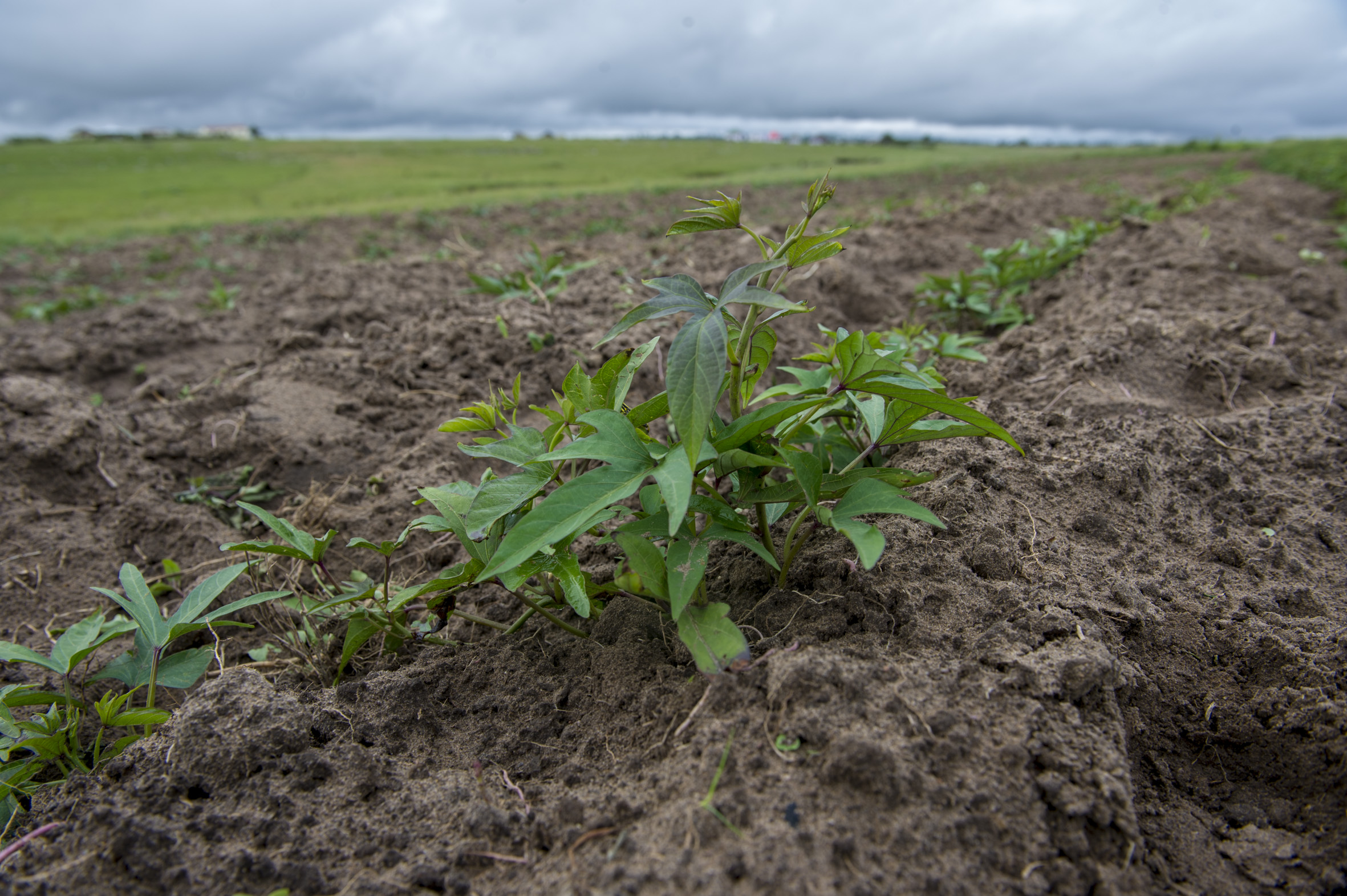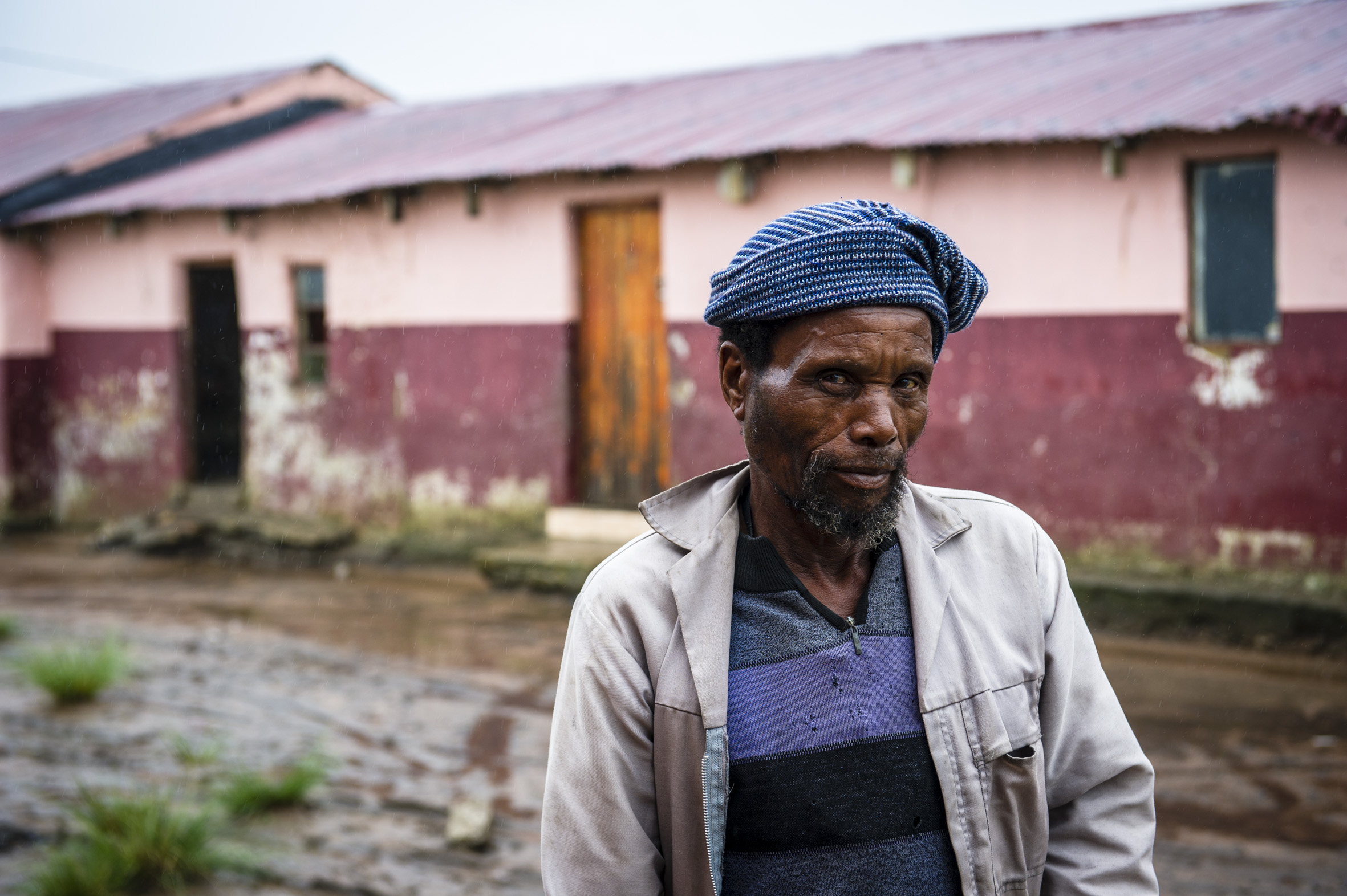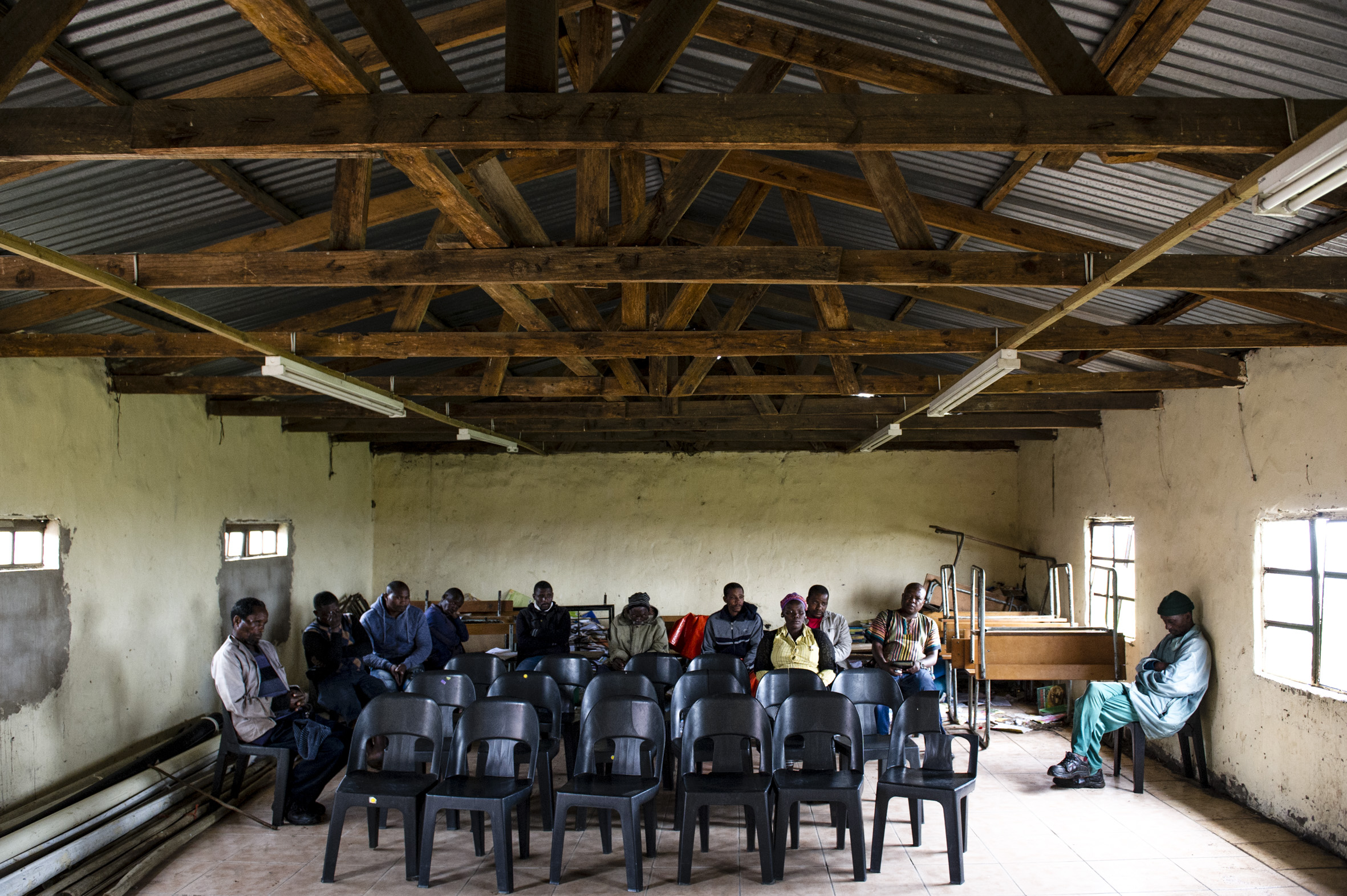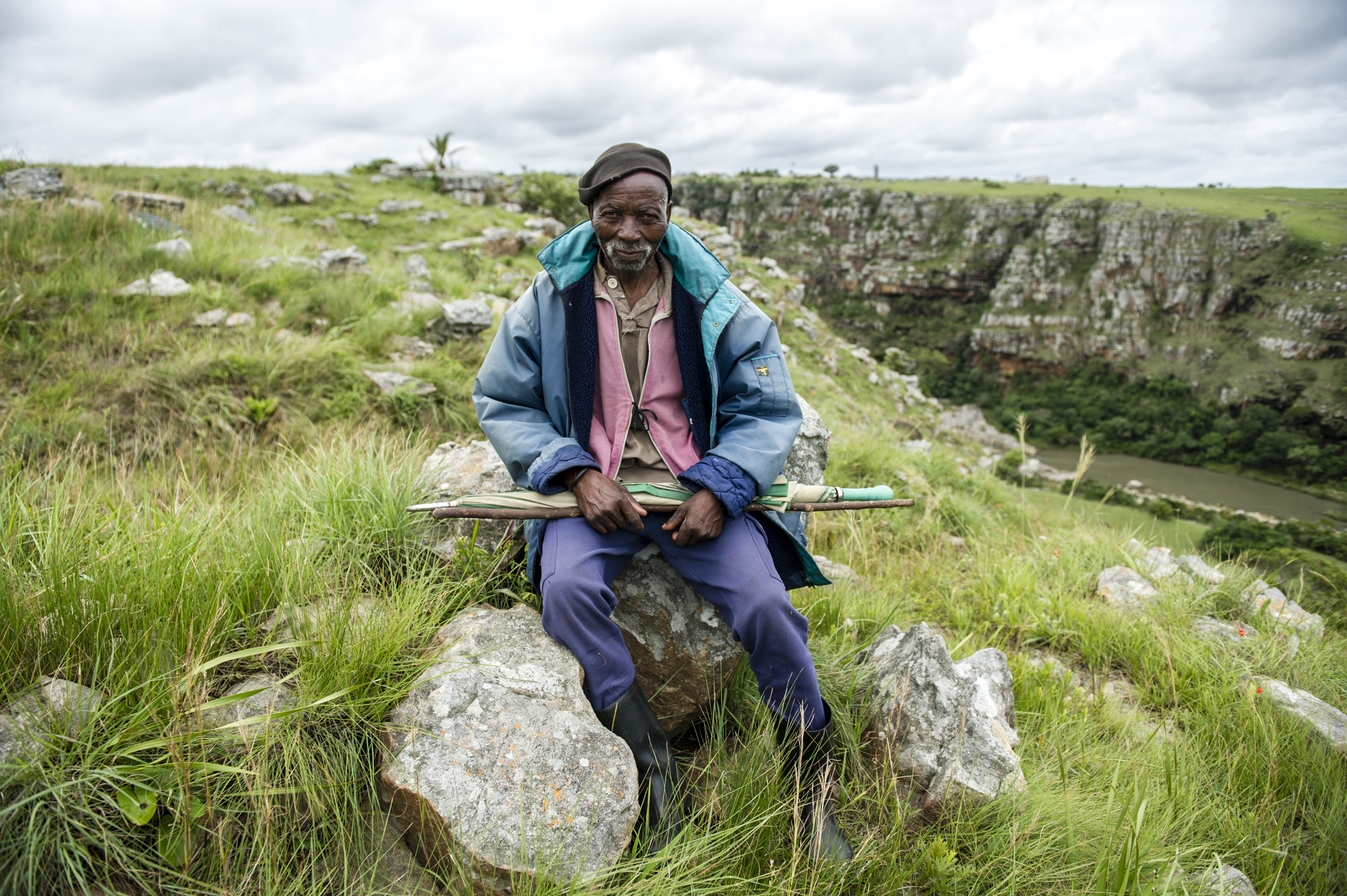Till: The sons of Mthulelwa Dlamini drive the cattle back to the homestead after they ploughed a field in preparation for planting
Mthulelwa Dlamini looks at his freshly ploughed field with satisfaction. His sons guide the oxen pulling the wooden sledge carrying the rusted iron plough used to carve deep furrows in the earth through the wet grass towards their home.
“We will start planting here tomorrow,” he says, wiping the sweat from his brow with the back of his calloused hand. The long leather whip he uses to drive the oxen hangs from his other hand.
It’s been raining continuously for almost a week in Sgidi. When the rain subsided, Dlamini rallied his family to one of their fields dotted around his homestead up in the hills.
Dlamini, like many of the families here, is a small-scale farmer who makes his living by ploughing the land all year round. He farms sweet potatoes and amadumbe.
The locals sell their produce to intermediaries who resell it at the market in Durban, some 200km away.
 [Livelihood: Small-scale farmers in Pondoland grow various crops, which they sell to intermediaries who sell them in the Durban market (Delwyn Verasamy)]
[Livelihood: Small-scale farmers in Pondoland grow various crops, which they sell to intermediaries who sell them in the Durban market (Delwyn Verasamy)]
It is a way of life in this village, which lies along the Eastern Cape’s Wild Coast. It has been for as long as the oldest people here can remember. The land has been, and remains, the heartbeat of life, an integral part of their survival and sustenance.
To the city eye, the village with its unsophisticated homesteads of brightly painted rondavels may give the false impression of poverty. Yet here, even without the trappings of material wealth, families live comfortably from the land.
But over this past decade a battle has raged in these parts for this heartbeat of life — the land.
“The land is like the intestines. If you remove the intestines, you will not live,” says Zenzele Gampe, one of the elders gathered in a classroom at the primary school.
 [Battle: Zenzele Gampe, like many others living along the Wild Coast, fears titanium mining will ‘eat’ the land on which he farms (Delwyn Verasamy)]
[Battle: Zenzele Gampe, like many others living along the Wild Coast, fears titanium mining will ‘eat’ the land on which he farms (Delwyn Verasamy)]
About a dozen people have braved the pouring rain to attend an important meeting at the school.
Sgidi is one of five villages that fall in an area targeted by Australian company Mineral Commodities Ltd (MRC), which wants to mine titanium along a 22km stretch on the Wild Coast. If it goes ahead, the Xolobeni Mine Sands Project will affect Sgidi, Mtentu, Sikombe, Kwayana and Mdatya.
But a long, protracted struggle by residents of the area, who have organised themselves under the Amadiba Crisis Committee, has temporarily halted the proposed mining.
Residents fear that mining will lead to the displacement of families, the destruction of the environment and, most crucially, the permanent elimination of the thriving subsistence and small-scale commercial farming economy.
The battle to stop mining has left a trail of blood in its wake, and 12 activists have been shot dead or poisoned in the past 10 years.
In September 2016, as resistance to the mining intensified after the suspected assassination of activist Sikhosiphi “Bazooka” Rhadebe in March that year, Minister of Mineral Resources Mosebenzi Zwane announced an 18-month moratorium on mining. It took effect at the end of June last year and ends in December.
The Amadiba are involved in another protracted legal battle, this time against the South African National Roads Agency Limited (Sanral) and the N2 Wild Coast Consortium, which want to build a highway that will cut through some of the villages. People fear that, just like mining, the highway will destroy their land and way of life.
Now the residents of Sgidi are exploring other development initiatives to counter the proposed mining. Through the Amadiba Coastal Community Development Trust (Accoda), they plan to develop a lodge close to the sea. They want to introduce ecotourism, which will includes teaching guests about village life, horse riding, cycling, walking trails and fishing.
 [Pushback: Sgidi residents meet to discuss sustainable alternatives to the Xolobeni Mineral Sands Project by Mineral Commodities (Delwyn Verasamy)]
[Pushback: Sgidi residents meet to discuss sustainable alternatives to the Xolobeni Mineral Sands Project by Mineral Commodities (Delwyn Verasamy)]
Mtentu village already has a functioning, popular lodge, which the community has leased out.
“Ecotourism is one of our alternatives [to mining] because we don’t want to just say tourism. In other places people are complaining of tourism. It’s very broad. In other areas communities are being displaced in the name of tourism,” says Nonhle Mbuthuma, a member of Accoda and the leader of the Amadiba Crisis Committee.
She has been forced to get bodyguards after threats on her life, which came soon after Rhadebe was killed.
“We need to say what kind of tourism we need [and] be careful of ensuring that people don’t get displaced. We need people to start tourism that is easy and fits into their lives,” she says.
On a rainy afternoon, she leads a group of locals and two officials from the department of environmental affairs to the proposed site for the lodge. The hour-long inspection reveals a land rich in indigenous medicinal plants, fruit, fresh water and breathtakingly beautiful views.
The officials express satisfaction and make suggestions. It all looks hopeful. But a long process of paperwork and general government bureaucracy and officialdom awaits.
There is an air of optimism among the residents, who have endured years of tension that has divided families and clans. Residents fears the moratorium may be a ploy to buy time and let the flames of rebellion subside so that mining can resume. Perhaps the lodge will bring an end to the threat of mining that will take away their way of life and livelihoods.
“We are the richest [people]. We have plenty of things that lots of people don’t have. We have land. We have clean water throughout the year. That is why we do agriculture throughout the year. We only buy what we can’t produce. There are no taps here. Even the municipality doesn’t deliver water here. We have clean natural water. And you call us poor?” says another elder, Mfihlelwa Mnyamane, as he scanning the landscape.
“Even if you have no food in the home, you just walk to the beach to fish and eat with your family. There is so much we get from that ocean.”
Streams of crystal-clear water, an important resource that feeds the agricultural economy, crisscross the grassy land.
 [Resistance: Mfihlelwa Mnyamane’s generation fought off apartheid planning and are still fighting to protect their way of life (Delwyn Verasamy)]
[Resistance: Mfihlelwa Mnyamane’s generation fought off apartheid planning and are still fighting to protect their way of life (Delwyn Verasamy)]
One of the most striking attributes of most parts of Mpondoland is the absence of fences and other boundaries. People use indigenous methods to keep livestock away from their crops, such as sprinkling cow dung along the furrows and planting certain herbs that keep goats and cattle away. People and livestock walk freely through the land, negotiating imaginary boundaries.
There are no designated cemeteries either. Instead, the dead are buried in the homestead, an integral part of affirming the people’s never-ending connection to the land. The homestead serves as the ancestral parliament of the clan, where the dead guard and preside over the land and the affairs of the living.
Unlike most of South Africa, which bears the scars of apartheid’s compartmentalisation strategies, Mpondoland has retained some semblance of what life was like before colonial rule. This is partly the legacy of a long and proud history of resistance in these parts.
Between 1950 and 1961 Mpondo-land became a thorn in the side of the apartheid authorities when its residents resisted its efforts to demarcate the area as part of the Bantu Authorities Act of 1951.
The amaMpondo “opposed the implementation of the land reclamation programme or Betterment Scheme … This scheme was about resettlements, stock control, rotational grazing, fencing off grazing land, culling, regular dipping and promotion of government-sponsored cattle sales,” according to SA History Online.
The scheme meant kraals would be “concentrated in certain areas, while certain lands would be used for plantations. In effect, the land rehabilitation scheme had made the Pondo people believe that they would lose their land. Therefore, they resisted an attempt to divide arable land from grazing land.”
The amaMpondo targeted those they labelled collaborators. Colluding chiefs were killed and their homes torched. White-owned businesses were boycotted. Those old enough to remember the uprising, which, in 1960, resulted in the death of 11 men by police at Ngquza Hill, are still haunted by memories of gunfire crackling from low-flying police and army aircraft.
In its bid to crush the ama-Mpondo, prime minister Hendrik Verwoerd’s regime instituted a state of emergency in November 1960, resulting in the arrest of more than 500 people. Thirty men were sentenced to death; 23 were executed at Pretoria Central Prison, apartheid’s death factory.
Although the rebellion was eventually crushed, Gampe, whose brother fought in the uprising, believes that his generation laid the foundation for the current generation to guard their land and protect it at all costs.
“The land is important to us because that’s what feeds us. We eat from the land. Mining will eat our land, which we farm. Where will our cattle graze? How many jobs will this mining really create? It will remove the intestines from the land. How will we survive after the mining?” asks Gampe.
As the long, uneasy wait continues, hoes and ploughs prepare for another harvest. The land, despite the prevailing uncertainty, is still the heartbeat of life here, just as it has been for more than a century. — Mukurukuru Media